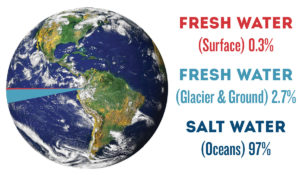
QUOTE OF THE DAY:
“… a lot of men fish all their lives without ever realizing that fish isn’t really what they’re after.” ~ Michael Baughman A River Seen Right (Lyons Press, 1995) p. 156, paraphrasing Henry David Thoreau (journal entry January 26, 1853)
CONTAMINANT CORNER – FERRIC IRON
WHAT IS IT? Ferric Iron in your water supply is iron that is oxidized to some extent. Ferrous iron is clear when drawn, but ferric iron will have some color when it is drawn from the tap.
HEALTH RISKS: Iron is listed in the EPA’S secondary standards. The secondary standards are non-enforceable guidelines for contaminants that cause cosmetic or aesthetic issues. Iron is not listed as a health risk.
SMCL: EPA’S maximum contaminate level is 0.3 mg/L.
CUSTOMER COMPLAINTS: Ferric iron (sometimes referred to as red water iron) will stain at the 0.3 mg/L level. Your customer might also complain of a metallic taste and/or odor. All of which will be objectionable to the homeowner.
TREATMENT: Long-term iron reduction is probably one of the most difficult treatment applications for the water treatment dealer. There is no one best way to remove this type of contaminate because the iron comes through as oxidized or partially oxidized.
Let’s start with using oxidizing filters. Oxidizing filters are designed to completely oxidize the iron and mechanically filter it. Most of these medias have additional requirements. They work better with a neutral pH, some use chemicals for regeneration, and still, others need specific levels of dissolved oxygen in the water supply to be effective. All these types of filters usually require additional maintenance. Oxidized iron by its very nature can foul the media causing iron bleed through and pressure drop. Good backwashes are required for long-term, trouble-free operation.
The most conservative method of iron removal is chlorination followed by filtration. A chemical feed pump injects household bleach into a holding tank fully oxidizing the iron. This process is followed by a filter designed to collect the oxidized material. You can use a variety of filter medias but activated carbon is always a good choice. The carbon will collect the oxidized material and at the same time, it will remove the chlorine. At some point, the carbon will be fully absorbed and must be replaced, but the benefit of removing the residual chlorine for the homeowner outweighs the cost of carbon replacement. This type of system also requires consistent management of the chlorine level in the solution tank. So, maintenance of all components is the key to success of chlorination.
An easier approach is an aeration unit. This unit oxidizes iron with a “bubble” of air contained in the top of the tank and a catalytic filtering media in the rest of the mineral tank. This system requires no regeneration with any kind of chemical but is backwashed frequently to remove the collected iron and replace the bubble of air. It is a “green” unit that is very effective.
The final unit is a water softener. However, it needs to be specially designed to remove iron otherwise oxidized iron will end up in your drinking water. This water softener must be designed with a unique resin and filtering media to filter out both Ferrous and Ferric iron. It still uses salt to regenerate and a resin cleaner is recommended, but these are very effective systems with little or no maintenance.
There is no single solution to remove iron so make certain you define the problem, look at all alternative courses of action, and along with your equipment supplier, select the best solution for your customer.
STUFF
 DID YOU KNOW?
DID YOU KNOW?
The water found in the Earth’s lakes, rivers, streams, ponds, and swamps account for only 0.3 percent of the worlds fresh water. The rest is in glaciers or in the ground. While 97 percent of water on earth is salty ocean water.
Credit where credit’s due
This month’s edition was brought to you by John Wenzel, President of Lancaster Water Group
For beautiful water and superior solutions, you can count on us.
Thank you for your business.
